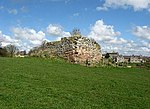Makerstoun

Makerstoun is a parish in the Scottish Borders area of Scotland, as well as the historic county of Roxburghshire, 4 miles (6 km) south-west of Kelso. The parish is bordered to the south by the river Tweed. It is bounded on the west by the parish of Mertoun in Berwickshire, on the north by the parish of Smailholm, on the east by the parish of Kelso and on the south by the parish of Roxburgh, across the River Tweed. The name of the parish reputedly means the town of Machar. For many centuries most of the land in the parish has been owned by the proprietor of Makerstoun estate, thus in the 19th century most of the land belonged to Sir Thomas Makdougall Brisbane of Makerstoun House (former Governor of New South Wales). Formerly, the greater part of the population was extremely fluctuating. All the families, except a few (nine in 1845), being the families either of farm servants or of tradesmen employed by the farmers, were liable to be removed every year. However, as the small farmers were dispensed with by the landlords, the population reduced from over 1,000 at the end of 18th century to 132 in 1981. The area of the parish is 2,865 acres (1,160 ha). The original medieval church was sited in the grounds of Makerstoun House (thus in the south of the parish near the Tweed), where some remains still exist. The first recorded minister of the church dates from 1567. In 1807 it was decided by the Makerstoun estate that the church, and the manse with its offices and garden should be moved to a more central site in the parish. A new church was thus built in 1808, which stands to the present day. The Community Council for Makerston is the Floors, Makerstoun, Nenthorn and Smailholm Community Council, which covers the parishes of Makerstoun and Smailholm in Roxburghshire, the parish of Nenthorn in Berwickshire and Floors Castle. It has 12 members, two of whom (as of 2015) were the Laird of Makerstoun and his wife.
Excerpt from the Wikipedia article Makerstoun (License: CC BY-SA 3.0, Authors, Images).Makerstoun
Geographical coordinates (GPS) Address Nearby Places Show on map
Geographical coordinates (GPS)
| Latitude | Longitude |
|---|---|
| N 55.586 ° | E -2.526 ° |
Address
TD5 7PA
Scotland, United Kingdom
Open on Google Maps










